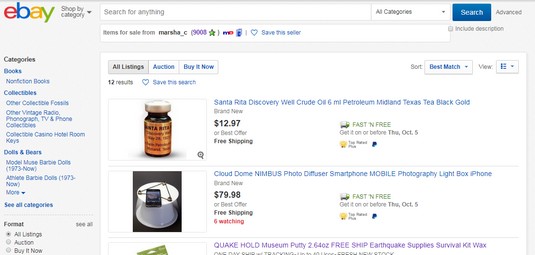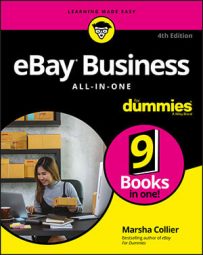Posting auctions, keeping records, cataloging inventory, managing photos, and gathering statistics are all tasks that you can automate. The more your business grows, the more confusing details may become. Automated tools can help you keep it all straight.
However, the more paid tools you use, the more expense you may be adding to your business. Always keep your bottom line in mind when evaluating whether to use fee-based software and services — eBay’s beginner Seller Hub is free.
You’ll have to perform back office tasks, no matter how few (or how many) listings you’re running. Depending on your personal business style, you may want to automate any or all of the following tasks. You may choose to use a single program, a manual method, or use some features from one program and some from others.Setting up a link to your eBay listings
Until you get an eBay Store, set up a link to your listings from your website or blog as a great alternative. That way, visitors to your site can browse your listings directly on eBay. You can produce your own listing gallery without any fancy programs or auction-management software, and at no additional cost.To make a link to your eBay listings without installing fancy scripts, you need to do two things:
- Test the following URL in your browser, substituting your own User ID in place of the bold italics:
www.ebay.com/sch/merchant/yourUserID My eBay listings from the link.
My eBay listings from the link. - After checking your link, insert the following HTML into your site to include a link to your eBay sales:
<a href="http:// www.ebay.com/sch/merchant/<em>yourUserID</em>"><b>Click <I>here</I> to view <em>YourUserID</em> Gallery</b></a>You can also use this in your emails to customers to show them just what’s for sale at any given moment.
Automating end-of-auction email
If you want to set up emails to be sent automatically after an auction ends, you must use a software application. The software should download your final auction results, generate the email, and let you preview the email before sending it out. Many online sites send out winner confirmation emails automatically when an auction is over.Keeping inventory
Many eBay sellers depend on the notebook method — crossing off items as they’re sold. If that works for you, great. Others prefer to use an Excel spreadsheet to keep track of inventory.Most of the management packages handle inventory for you. They automatically deduct an item from inventory when you launch an auction or when the item ships. You have your choice of handling inventory directly on your computer or keeping your inventory online with a service that’s accessible from any computer, wherever you are.
QuickBooks is also a good source for bookkeeping tasks.
Composing HTML for listings
Fancy descriptions are nice, but fancy doesn’t make the item sell any better. Competitive pricing and low (free?) shipping rates work in your favor — especially with Best Match search. Also, a clean listing with as many photos as necessary goes a long way toward selling your product. Some software and services offer a large selection of templates you can use to gussy up your descriptions.The use of simple HTML doesn’t slow the loading of your page, but the addition of miscellaneous images (decorative backgrounds and animations) can make viewing your item a distasteful chore.
Don’t fret; you can make do by repeatedly incorporating two or three simple HTML templates, cutting and pasting new text as necessary. Most listing programs offer you several template choices. It’s a good idea to stick with a few that are similar, giving a standardized look to your listings — which is just the way major companies give a standardized look to their advertising and identity. Your customers will get used to the look of your auctions and feel comfortable each time they see one.
SeaMonkey Composer (a free program from the people who brought the Firefox Internet browser) is a good program for generating for auction descriptions.
An important line of code that everyone seems to forget is the one that inserts a picture into your auction description. You need (due to eBay policy) to embed any images that have text you inserted within your description. These types of images are no longer allowed as your main eBay pictures. On the Sell an Item page, click the tab to view in HTML mode, and insert the following line below where you’d like your image to appear in your description:
<img src="http://www.<strong><em>yourwebsiteserver.com/imagename.jpg</em></strong>">Be sure to substitute your own server and image name. If you want to put one picture above another, type
and then repeat the HTML line with a different image name.
Scheduling listings for bulk upload
If you're a store owner and want to schedule a future automated launch of your listings without incurring eBay’s $.10 fee, you must use an online management service.Checking out
When someone wins or buys an item, eBay’s checkout integrates directly with PayPal. If you’re closing less than 100 sales a day, that’s all you need. eBay and PayPal will also send an email to you and the buyer so that you can arrange for payment.A personalized winner’s notification email can easily contain a link to pay, making a checkout service unnecessary.
Printing shipping labels
Printing shipping labels without printing postage can be the beginning of a laborious two-step process. You could try out some alternatives: Endicia (for Mac and Windows), Stamps (Windows), and eBay for all operating systems — all of which can print your labels and postage in one stepGenerating customized reports
Sales reports, ledgers, and tax information are all important reports that you should have in your business. Online services and software supply different flavors of these reports.PayPal allows you to download your sales data into a format compatible with QuickBooks. You can also choose to download your data in Excel spreadsheet format. PayPal reports are full of intensely detailed information about your sales and deposits. Putting this information in a standard accounting software program on a regular basis can make your year-end calculations easier to bear.

